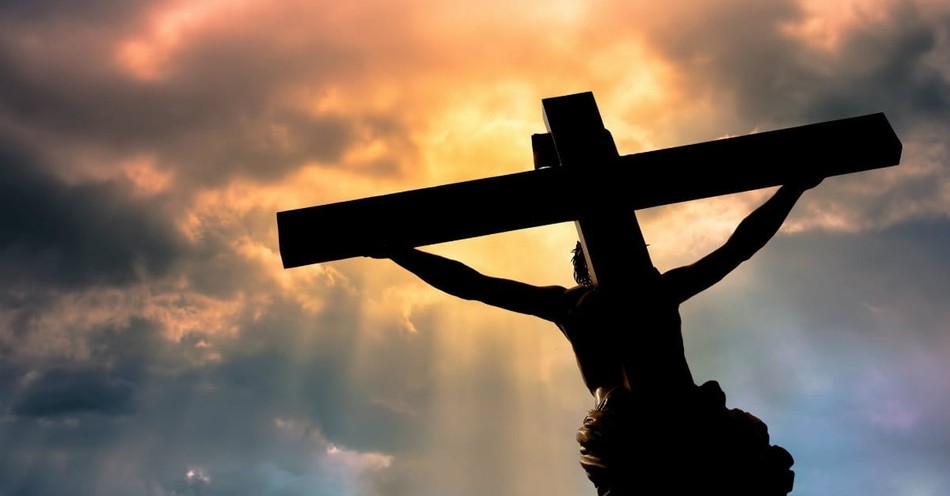The question of "When did Jesus die?" arises in popularity each year around the time of Good Friday, the Christian holiday commemorating the Crucifixion of Christ. Many wonder if we know precisely when Jesus died on the cross. Does the Bible tell us the hour, day, and year of Jesus' death? What can historical evidence provide to know when Jesus died?
Table of Contents
Get your FREE 8-Day Prayer and Scripture Guide - Praying Through the Holy Week HERE. Print your copy for a beautiful daily devotional leading up to Easter.
When Did Jesus Die?
According to the best estimates of biblical scholars and historical evidence, Jesus died on Friday, April 3rd, AD 33, at approximately 3 PM, a few hours before the beginning of Passover day and the Sabbath. This is the date in the Julian calendar, which was introduced in 45 BC and follows the convention that historical dates adhere to the calendar used at the time.
Time: 3 PM ("The Ninth Hour")
Day of Week: Friday, April 3rd
Year: 33 AD
Let's dive into how each of these was determined from biblical context and historical research:
The Hour of Jesus' Death
And about the ninth hour Jesus cried with a loud voice, saying, Eli, Eli, lama sabachthani? that is to say, My God, my God, why hast thou forsaken me? Some of them that stood there, when they heard that, said*, This man calleth for Elias. And straightway one of them ran, and took a spunge, and filled it with vinegar, and put it on a reed, and gave him to drink. The rest said, Let be, let us see whether Elias will come to save him. Jesus, when he had cried again with a loud voice, yielded up the ghost. (Matthew 27:46-50 KJV)
Matthew Henry explains in his commentary Jesus was nailed to the cross between the third and the sixth hour, that is, between nine and twelve o’clock. And he died soon after the ninth hour, that is, between three and four o’clock in the afternoon.
As stated above, the Jews at the time of Christ measured days from nightfall to nightfall. Therefore, Bible scholars can take Matthew 27:46 KJV, “ninth hour,” and translate it to Matthew 27:46 NIV, “three in the afternoon.”
Times of the Crucifixion in the Gospels
Mark 15: 33:34, 37: “At noon, darkness came over the whole land until three in the afternoon. And at three in the afternoon Jesus cried out in a loud voice, ‘Eloi, Eloi, lema sabachthani?’ (which means ‘My God, my God, why have you forsaken me?’) …With a loud cry, Jesus breathed his last.”
Luke 23:44-46: “It was now about noon, and darkness came over the whole land until three in the afternoon, for the sun stopped shining. And the curtain of the temple was torn in two. Jesus called out with a loud voice, ‘Father, into your hands I commit my spirit.’ When he had said this, he breathed his last.”
John 19:14-16: “It was the day of Preparation of the Passover; it was about noon. ‘Here is your king,’ Pilate said to the Jews. But they shouted, ‘Take him away! Take him away! Crucify him!’ ‘Shall I crucify your king?’ Pilate asked. ‘We have no king but Caesar,’ the chief priests answered. Finally Pilate handed him over to them to be crucified.”
The Day of Jesus' Death
Speculation about the day of Christ's crucifixion and death stems from the lack of direct day-to-day correlation in the Gospel accounts. We know from the four Gospel accounts that Jesus died on Preparation Day.
The Apostle Matthew includes the longest account of Jesus’s death and burial (Matthew 27:31-62). One element of this account is the information about Joseph, a rich man from Arimathea “who had himself become a disciple of Jesus,” (Matthew 27:57b). Joseph is reported to have asked Pilate for permission to bury Jesus’ body in Matthew 27:58-61. Then we learn in Matthew 27:62 that Joseph carried this out on Preparation Day: “The next day, the one after Preparation Day, the chief priests and the Pharisees went to Pilate.”
The Apostle Mark also records that Joseph buried Jesus on Preparation Day. “It was Preparation Day (that is, the day before the Sabbath)” (Mark 15:42a) … “So Joseph bought some linen cloth, took down the body, wrapped it in the linen, and placed it in a tomb cut out of rock. Then he rolled a stone against the entrance of the tomb” (Mark 15:46).
The Apostles Luke and John confirm that Jesus died on the Day of Preparation:
“Then he took it down, wrapped it in linen cloth and placed it in a tomb cut in the rock, one in which no one had yet been laid. It was Preparation Day, and the Sabbath was about to begin” (Luke 23:54).
“Because it was the Jewish day of Preparation and since the tomb was nearby, they laid Jesus there” (John 19:42).
According to the University of Chicago,
"In John, moreover, this Passover fell on a Saturday, coinciding with the weekly Sabbath. "That sabbath day was a high day" (John 19:31), in which the two festivals were celebrated on the same day, and Friday (Nisan 14) was the Day of Preparation for them both. This was the same time that the lambs were being prepared for the Passover feast at moonrise later that evening and the beginning of Passover Day (Nisan 15). Jesus himself has become the sacrificial lamb or, in the words of John the Baptist, "the Lamb of God, which taketh away the sin of the world" (John 1:29, 1:36), dying at the same time as the paschal lambs were being ritually slaughtered in the Temple—as prefigured by 1 Corinthians "For even Christ our passover is sacrificed for us" (1 Corinthians 5:7).
If Jesus died on the Day of Preparation (Nisan 14), in what years during the prefecture of Pontius Pilate (AD 26–36) did that day fall on a Friday? Using astronomical data, Humphreys and Waddington have calculated that there are only two possible dates during this decade that a Friday crucifixion could have occurred on Nisan 14: either April 7, AD 30, or April 3, AD 33. A Friday Passover on Nisan 15 (as the Synoptic Gospels contend) would be in the year AD 27 (two years before Jesus himself was baptized) or AD 34 (the probable year of Paul's conversion), which almost certainly is too early or too late."
The Year of Jesus' Death
Doug Bookman, a New Testament professor at Shepherds Theological Seminary, explains the consensus among biblical scholars about the year Jesus died.
“It comes down to this. We can discern quite narrowly that Pilate was prefect in Judea Samaria 26 A.D. – 36 A.D. So that’s our window. The next question becomes: On what day did Passover fall in the year Jesus died? In the minds of most, it fell on Thursday/Friday. It started on sundown on Thursday and went through sundown on Friday. Given all of that, most scholars will agree it drives you to one of two conclusions:”
Theory 1: Jesus died in 30 A.D.
Theory 2: Jesus died in 33 A.D.
Bookman says at this point, “the argument becomes quite technical.” He also says, “With regard to every one of the chronological questions, there is a case to be built on both. I am persuaded of 33 A.D. It’s within that construct that I teach the life of Jesus.” Watch his full answer to the question, "In what year did Jesus die?" below:
Furthermore, the University of Chicago states that "Humphreys and Waddington have calculated there was a partial lunar eclipse of the full moon as it rose above Jerusalem on Friday, April 3, AD 33, thus fulfilling the prophecy quoted by Peter that "The sun shall be turned into darkness, and the moon into blood, before that great and notable day of the Lord come" (Acts 2:20, cf. Joel 2:31). Certainly, it was fitting that the blood smeared on the door frames of the Israelites in Egypt as "a token upon the houses where ye are" (Exodus 12:13) should prefigure a sanguine moon rising above Jerusalem that night—especially since the eclipse occurred just at moonrise when Jews on Passover Day would have been particularly observant as they waited to commence their evening meal...
There was another incident, this one historical rather than astronomical, that supports the crucifixion of Jesus in AD 33: the death in Rome of the praetorian prefect Lucius Sejanus, commander of the imperial guard, two years before. Retiring to Capri in AD 26, Tiberius effectively abdicated his imperial responsibilities to Sejanus, who appointed Pilate prefect of Judaea that year. Both men were virulently anti-Jewish: Sejanus "desirous to destroy our nation" (On the Embassy to Gaius, XXIV.160; Against Flaccus, I.1), and Pilate determined "to abolish the Jewish laws" (Josephus, Antiquities of the Jews, XVIII.3.1).
3 Significant Events Right After Jesus’ Death
“At that moment the curtain of the temple was torn in two from top to bottom. The earth shook, the rocks split and the tombs broke open. The bodies of many holy people who had died were raised to life. They came out of the tombs after Jesus’ resurrection and went into the holy city and appeared to many people. When the centurion and those with him who were guarding Jesus saw the earthquake and all that had happened, they were terrified, and exclaimed, “Surely he was the Son of God!” (Matthew 27:51-54)
1. The temple curtain was torn in two.
This curtain separated worshippers in the temple from the Ark of the Covenant and its top – the Mercy seat, where God would meet only the High Priest once a year with an atonement sacrifice. We know from Old Testament regulations that entering God’s presence was serious. After two men died attempting it incorrectly, the Lord gave Moses specific instructions in Leviticus 16 on how to approach him without dying.
The fact that this curtain was destroyed symbolized Jesus Christ’s finished work on the cross that removed the barrier between sinful mankind and holy God by becoming the ultimate High Priest and the ultimate sacrifice. Further, the fact that the curtain was torn “from top to bottom” symbolized that it was torn by God himself, not by the effort of any man.
2. An earthquake opened tombs, and dead saints were raised to life.
According to John Gill’s commentary, “this was a proof of Christ's power over death and the grave.”
As Jesus raised himself to life on the third day after he died, he defeated death's power and the grave's permanency. Gill went on: “These saints, I apprehend, continued on earth until our Lord's ascension, and then joining the retinue of angels, went triumphantly with him to heaven, as trophies of his victory over sin, Satan, death, and the grave.”
This event is significant not only because of its bold claims but also because it is a story foreshadowing Christ’s second coming to gather all the rest of his people. This event reported in Matthew also fulfills a prophecy in Isaiah 26:19, “But your dead will live, LORD; their bodies will rise— let those who dwell in the dust wake up and shout for joy— your dew is like the dew of the morning; the earth will give birth to her dead.”
3. Jesus is resurrected from the grave.
This passage in Matthew glosses over such an astonishing event, but Christ’s Resurrection is recounted with more detail in Matthew 28 (as well as in Mark 16, Luke 24, and John 20).
Photo Credit: Unsplash/Joshua Earle









